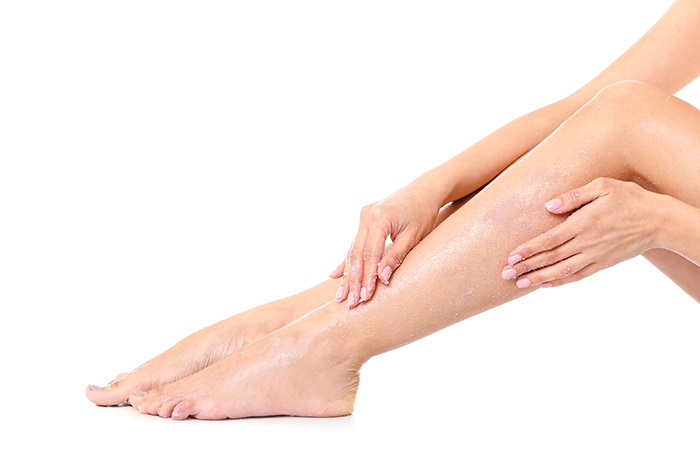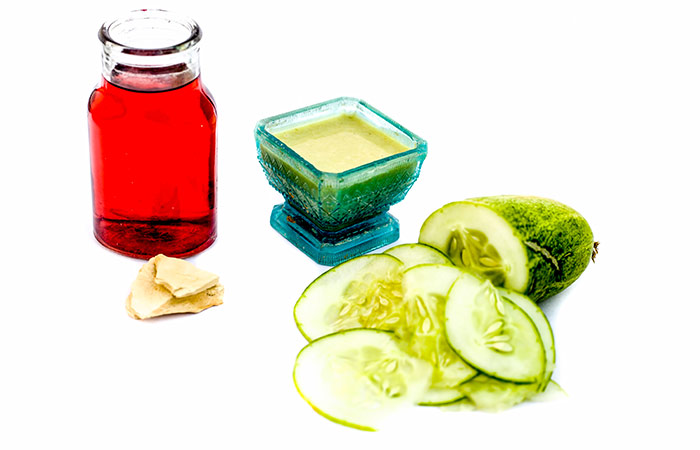How To Get Rid Of Strawberry Legs With Baking Soda
Do you have dark spots on your legs? Do the pores look darker than usual – like black dots? Then, you may have strawberry legs.
Strawberry legs or comedones are dark bumps on your leg that look like the skin and seeds of strawberries.
This condition is very common and can easily be taken care of by using simple home remedies.
What Are Strawberry Legs?
Strawberry legs are nothing but the presence of small black dots just beneath the upper layer of the skin. This gives your legs a strawberry-like appearance, hence the name.
These pores, also called open comedones, are hair follicles or ingrown hair that are trapped under the skin. They may also contain a mixture of bacteria, dead skin cells, and oil.
They are not harmful in any way but can make you feel self-conscious.
Strawberry legs look similar in most people, but the causes may be different for each person.
What Causes Strawberry Legs?
Here are some common causes of strawberry legs:
- Keratosis pilaris – This is also known as chicken skin and occurs when your skin produces excessive keratin, which blocks the hair follicles. This leads to tiny bumps and patchy skin.
- Dry Skin – If your skin is not well moisturized, it becomes dry and rough. This makes your epidermis vulnerable to irritation caused by shaving.
- Folliculitis – This is a condition in which your hair follicles are inflamed. It might happen due to bacteria or fungi. Folliculitis results from ingrown hairs from shaving.
If you have strawberry legs, you are most likely experiencing one or more of the following symptoms.
What Are The Symptoms Of Strawberry Legs?
- Strawberry-like appearance of your legs
- Small reddish or blackish bumps on your legs
- Clogged pores on the skin
- Rough, dry, and irritated skin
Listed below are a few home remedies that can help you deal with strawberry legs.
Home Treatment For Strawberry Legs
1. Baking Soda

Shutterstock
Baking soda works as an anti-inflammatory and antibacterial agent (1). It exfoliates your skin and makes it smooth and radiant. It is also known to prevent and treat severe dryness of the skin (2).
You Will Need
- 1 tablespoon of baking soda
- 1 teaspoon of water
What You Need To Do
- Make a paste by mixing the baking soda and water.
- Apply this mixture to the affected area on your legs and let it dry for 4 to 5 minutes.
- Rinse with cold water.
How Often You Should Do This
You can try this remedy every day.
2. Exfoliation

Shutterstock
Exfoliating helps remove dead cells from the top layer of the skin and gets rid of any bacteria that might be present. It also eliminates the chances of ingrown hair.
You Will Need
- ½ cup of brown sugar
- ½ cup of almond or olive oil
- 3-4 drops of clove oil
What You Need To Do
- Mix all the ingredients to make a paste.
- Apply the paste to the legs and rub in circles for a few minutes to exfoliate the skin.
- Rinse with cold water.
How Often You Should Do This
You can exfoliate your legs 1-2 times a week until you start noticing a difference in your legs.
3. Aloe Vera

Shutterstock
Aloe vera is a very powerful moisturizer and has excellent skin healing properties (3). Applying it every day will always keep the skin hydrated.
You Will Need
1 leaf of fresh aloe vera
What You Need To Do
- Extract the gel from a fresh aloe vera leaf.
- Apply this gel on your legs and massage gently for a minute or two.
- Leave it on for about 10 minutes.
- Rinse with cold water.
How Often You Should Do This
Apply aloe vera gel on your legs every day.
4. Sea Salt

Shutterstock
Sea salt is packed with minerals like calcium, sodium, magnesium, and potassium (4). These minerals play a major role in our skin's health and pH balance. When the mineral balance of the body is disturbed, our skin shows symptoms, such as dryness, itchiness, and irritation. Applying a sea salt scrub on the body removes dead cells from the skin's surface and restores mineral balance in the body.
You Will Need
- ¼ cup of sea salt
- ½ cup of coconut oil
- A washcloth (optional)
What You Need To Do
- Mix the sea salt and coconut oil to form a thick paste.
- Using a washcloth or your palms, scrub this mixture gently on your legs.
- Continue for a minute or two and then rinse with water.
How Often You Should Do This
As sea salt can be abrasive on the skin, don't use this scrub every day. Use it 1-2 times a week to notice results in a month's time.
5. Ground Coffee

Shutterstock
Ground coffee works as a great exfoliator for the skin. When mixed with olive or coconut oil, it helps in sloughing dead cells and leaves the skin smooth and radiant.
You Will Need
- ½ cup of ground coffee
- ½ cup of palm sugar
- ¼ cup of coconut oil
What You Need To Do
- Make sure all the ingredients are at room temperature.
- Mix them in a bowl to form a scrub.
- Apply on the legs in a circular motion and rinse off with water.
How Often You Should Do This
You can use this scrub to exfoliate your legs 1-2 times a week.
6. Tea Tree And Jojoba Oil

Shutterstock
Both tea tree oil and jojoba oils have antimicrobial and anti-inflammatory properties and can treat dry, dead skin (5), (6). These oils can speed up wound healing and treat skin issues like dryness and itching and prevent clogged pores.
You Will Need
- 2-3 drops of tea tree oil
- 1 tablespoon of jojoba oil
What You Need To Do
- Mix the tea tree oil and jojoba oils.
- Massage this mixture onto your legs. Let your skin absorb this for 5-10 minutes. Rinse with water.
How Often You Should Do This
You can use this remedy every night before bedtime.
7. Buttermilk Bath

Shutterstock
Buttermilk contains lactic acid, which is a natural chemical exfoliant. It can leave your skin brighter and smoother.
You Will Need
- 1 cup of buttermilk
- A bucketful of water
What You Need To Do
- Run a bath and add a cup of buttermilk to your bathwater.
- Soak yourself in this buttermilk and water mixture for a few minutes.
- Shower as usual.
How Often You Should Do This
You can do this every day to keep your skin radiant and avoid clogged pores.
8. Moisturize

Shutterstock
Keeping your skin well moisturized at all times prevents dryness and skin irritation. Shaving over irritated skin results in strawberry legs.
You Will Need
A good moisturizer
What You Need To Do
- Pour some moisturizer on your palms.
- Rub your hands together and spread the moisturizer evenly throughout your body.
How Often You Should Do This
You should moisturize your body as often as you can – every day after a shower.
9. Rose Water and Cucumber

Shutterstock
Cucumber is rich in Vitamin C, which prevents skin irritation. It also has calming and anti-inflammatory properties (7).
Rose water is known to calm the skin and open clogged pores (8).
You Will Need
- 1 cucumber
- A few drops of rose water
What You Need To Do
- Blend the cucumber until it is juiced.
- Add a few drops of rose water to the cucumber juice and mix well.
- Apply this mixture to your legs and let it dry for about 10 to 15 minutes.
- Rinse with water.
How Often You Should Do This
You can do this every day. Repeat it until you start seeing visible results on your legs.
10. Egg Whites And Lemon Juice

Shutterstock
Egg whites tighten and brighten the skin. They contain a plethora of nutrients – proteins, vitamins, and minerals that nourish our skin. Egg whites are also powerful astringents that can clean and reduce pores (9). Lemon juice is a natural bleaching agent (10).
You Will Need
- 1 egg white
- 1 teaspoon of lemon juice
What You Need To Do
- Mix the egg white and the lemon juice.
- Using a brush (or your fingers), apply this mixture on your legs.
- Leave it on for 5-10 minutes and rinse with water.
How Often You Should Do This
You can do this once every day, preferably before your shower.
If home remedies do not work for you or if you want a more permanent solution for your strawberry legs, consult a dermatologist. They might suggest a chemical peel or a laser hair removal.
Medical Professional Treatment: Laser Hair Removal
Laser hair removal uses concentrated light to destroy hair follicles beneath your skin surface. It usually takes about 4 to 6 sittings to get rid of all your hair permanently.
Some people might experience some hair growing back at a later stage, which can be taken care of by another sitting of laser treatment.
This treatment is perfectly safe and is used by several people across the globe.
Here are a few tips to make your legs soft.
Tips To Get Soft Legs Naturally
- Drink plenty of water every day.
- Scrub your body and exfoliate dead cells at least 1-2 times a week.
- Moisturize your skin immediately after a shower. You can also moisturize at night before bed. Always use a good quality moisturizer.
- Use sunscreen to prevent the harmful UV rays from damaging your skin. Always apply sunscreen at least 15 to 20 minutes before you step out.
- Use safe hair removal methods, like waxing or epilating. These methods remove the hair from the root and prevent any possibility of ingrown hair.
- Eat healthy to give your body the nourishment it deserves.
- Get frequent body massages done to get your circulation going.
You need not think twice before wearing those pretty skirts and dresses and flaunting your legs. Be consistent with these remedies and tips, and you will surely be able to get rid of strawberry legs. However, if the remedies don't work or the condition frequently recurs, talk to a dermatologist.
Do you have any more questions? Post them in the comments section, and we'll get back to you.
Frequently Asked Questions
How long does it take to get rid of strawberry legs?
It can take up to a month or two to get rid of strawberry legs, depending on how receptive your skin is to natural remedies.
Does waxing get rid of strawberry legs?
Yes, waxing can get rid of strawberry legs over a period since it pulls the hair out from the roots.
How do you treat ingrown hairs on your legs?
Ingrown hair can be treated by exfoliating on a regular basis. You could go for laser hair removal to put an end to ingrown hairs. Do not pluck or wax them since they might get more irritated and turn red.
What causes a strawberry hemangioma?
A strawberry hemangioma is a reddish birthmark that occurs due to a collection of blood vessels just below the surface of the skin. This abnormal growth of blood vessels growing just below the skin can turn into a benign tumor.
Are strawberry legs permanent?
No, strawberry legs are not permanent. You can easily get rid of them by trying any of the above home remedies or laser hair removal.
Sources
Articles on StyleCraze are backed by verified information from peer-reviewed and academic research papers, reputed organizations, research institutions, and medical associations to ensure accuracy and relevance. Check out our editorial policy for further details.
- Antibacterial activity of baking soda. Compendium of Continuing Education in Dentistry. Supplement, US National Library of Medicine, National Institutes of Health.
https://www.ncbi.nlm.nih.gov/pubmed/12017929 - Ichthyosis with confetti: a rare diagnosis and treatment plan. BMJ Case Reports, US National Library of Medicine, National Institutes of Health.
https://www.ncbi.nlm.nih.gov/pmc/articles/PMC4112313/ - Topical Application of Aloe vera Accelerated Wound Healing, Modeling, and Remodeling: An Experimental Study. Annals of Plastic Surgery, US National Library of Medicine, National Institutes of Health.
https://www.ncbi.nlm.nih.gov/pubmed/25003428 - Natural sea salt consumption confers protection against hypertension and kidney damage in Dahl salt-sensitive rats, Food & Nutrition Research, US National Library of Medicine, National Institutes of Health.
https://www.ncbi.nlm.nih.gov/pmc/articles/PMC5328355/ - A review of applications of tea tree oil in dermatology. International Journal of Dermatology, US National Library of Medicine, National Institutes of Health.
https://www.ncbi.nlm.nih.gov/pubmed/22998411 - Jojoba in dermatology: a succinct review. Giornale italiano di dermatologia e venereologia, US National Library of Medicine, National Institutes of Health.
https://www.ncbi.nlm.nih.gov/pubmed/24442052 - Phytochemical and therapeutic potential of cucumber. Fitoterapia, US National Library of Medicine, National Institutes of Health.
https://www.ncbi.nlm.nih.gov/pubmed/23098877 - Pre-Feasibility Study: Rose Water. Small and Medium Enterprise Development Authority, Government of Pakistan.
http://www.amis.pk/files/PrefeasibilityStudies/SMEDA%20Rose%20Water.pdf - DIY Skincare Straight From Your Kitchen. OGLE School.
https://www.ogleschool.edu/blog/diy-skincare-straight-kitchen/ - The Hunt for Natural Skin Whitening Agents. International Journal of Molecular Sciences, US National Library of Medicine, National Institutes of Health.
https://www.ncbi.nlm.nih.gov/pmc/articles/PMC2801997/
Was this article helpful?
The following two tabs change content below.
- Author

Shaheen holds a postgraduate degree in Human Genetics and Molecular Biology. She is a Geneticist with proficiency in Biotechnology, Immunology, Medical Genetics, Biochemistry, Microbiology, and Genetic Counseling. Her passion for writing and her educational background have assisted her substantially in writing quality content on topics related to health and wellness. In her free time, Shaheen loves to explore the world and the different flavors/cuisines it has to offer. Photography is another hobby she has developed of late.
How To Get Rid Of Strawberry Legs With Baking Soda
Source: https://www.stylecraze.com/articles/how-to-get-rid-of-strawberry-legs/
Posted by: judkinswrue1972.blogspot.com

0 Response to "How To Get Rid Of Strawberry Legs With Baking Soda"
Post a Comment